Choosing the Right Pet Bird for Your Child's Happiness
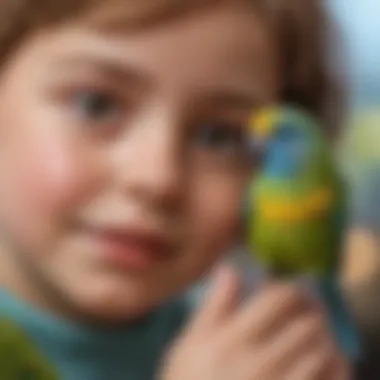
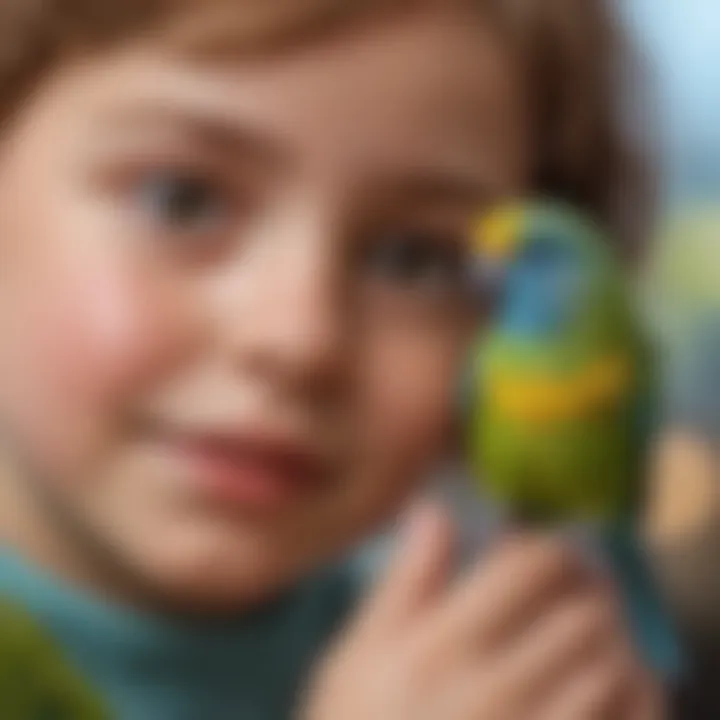
Intro
Selecting a pet bird for a child can be a rewarding yet challenging decision. Birds, with their vibrant feathers and melodic songs, can captivate any child. However, they also require a considerable amount of care and attention that all family members need to consider. When parents decide to add an avian companion to their family, they must think about various factors. Understand not only the child’s aspirations but also the specific needs and behaviors of different bird species.
Birds can offer emotional support, enhance responsibility, and provide educational opportunities about wildlife. Each species brings its distinct set of characteristics, habits, and requirements. Parents should weigh these characteristics against their child's age, maturity, and level of engagement concerning pet care.
In this article, we will explore different factors to consider, focusing on the key elements of bird care, insight into their behavior, nutritional needs, health protocols, and activities that can enhance the bond between child and bird.
Each section aims to inform parents not only about the joys of bird ownership but also about the relevant responsibilities and care required to ensure a positive experience for both the child and the pet bird.
Through this comprehensive approach, parents can make a balanced and selective choice that ensures the well-being of all involved, fostering a deeper knowledge and a beneficial relationship with their new avian family member.
Care Tips
Daily Care Routines
Daily care for pet birds involves a variety of essential tasks. Birds thrive from structured routines, and creating a reliable schedule can foster a safe environment for them. Morning rituals typically commence with providing fresh water, ensuring their cages are cleaned, and preparing food based on their dietary requirements. Investing time each day toward interaction can help in socializing the bird, allowing them to develop trust.
Cage Setup and Maintenance
An appropriate cage setup is more than just a home; it encompasses comfort and security. A spacious cage allows for exercise and play, while providing essential items such as perches, feeding dishes, and toys prevents boredom. Regular maintenance involves cleaning the cage to maintain hygiene and performing routine safety checks to prevent injury from loose items.
Hygiene and Cleaning Practices
Keeping the environment clean is paramount for the health of both birds and children. Discarding previous food remnants, replacing bedding, and cleaning toys when necessary stops the growth of bacteria. Using non-toxic cleaning materials is crucial to safeguarding the health of your avian child.
Seasonal Care Adjustments
Birds can be sensitive to changing weather conditions. During colder months, consider providing a warm habitat, perhaps using a heater. In the warmer season, ensuring ample ventilation is critical to maintaining a comfortable environment. Regular adjustments reflecting seasonal changes are essential to the pet's health.
Behavioral Insights
Understanding Bird Body Language
Birds communicate primarily through body language, and understanding their signals helps in fostering a stable relationship. A bird’s posture, feather position, and vocal sounds all convey feelings of comfort or stress, making observation a key tool for understanding their needs.
Common Behavioral Issues and Solutions
Behaviors such as biting, excessive squawking, or feather plucking can indicate underlying issues. Addressing these challenges begins with recognizing triggers, whether they are linked to environmental stressors or changes in interaction patterns. Often, providing additional mental stimulation or playtime can correct unwanted behavior.
Positive Reinforcement Techniques
When training birds, employing positive reinforcement helps in teaching new behaviors. A system involving treats or praises when the bird obeys commands can strengthen bonds and build trust. Proper rewards will encourage the bird to repeat desired behaviors and can make the training sessions enjoyable.
Social Interaction Needs
Social creatures at heart, many birds need socialization, particularly if kept in isolation. Incorporating family members into playtime not only strengthens human-avian relationships but encourages a more favorable environment for the bird.
Nutrition Guides
Essential Diet Components
Feeding pet birds involves a well-balanced mix of seeds, fresh fruits, and vegetables. Understanding the nutritional requirements specific to different species ensures proper growth and health. Consult ava-approved resources for more detailed dietary insights.
Safe and Toxic Foods
Some foods can be harmful to birds. Common toxic foods include chocolate, caffeine, and certain nuts. It’s vital to educate children on these consequences in a safe and age-appropriate manner, creating a teaching opportunity.
Supplements and Treats
Occasionally, birds may benefit from specific dietary supplements like vitamins. Natural treats such as whole grains or cooked legumes introduce diversity in their diet and provide mental stimulation, helping explore different choices on safe moderation.
Feeding Strategies for Different Species
Different species also have different feeding habits; understanding this is essential. Larger birds like African Grey Parrots have varied needs compared to smaller finches and parakeets. Each species will present unique dietary requirements that parents should research carefully.
Wellness and Health
Routine Health Checkups
Regular checkups with a veterinarian is essential in bird care. Like all pets, birds deserve preventive care which can help catch potential health issues early before they escalate. Scheduling routine appointments helps in ensuring long-term well-being.
Identifying Symptoms of Illness
Keeping an eye on the bird’s behavior can provide insights into its health. Changes in eating habits, lethargy or feather deterioration are signs that may indicate issues that warrant immediate attention. Parents need to already establish a basic understanding of avian health indicators and engage children in these observations.
Preventative Care and Vaccinations
Cleaning practices and balanced diets contribute to a healthy lifestyle, yet preventive veterinary care, including vaccinations, cannot be overlooked. Establishing an ongoing relationship with an avian vet can introduce parents to preventive measures specific to their bird’s species.
Mental and Emotional Well-being
Birds require mental stimulation to thrive. Activities that challenge and engage them help maintain emotional health, ultimately creating a more harmonious environment at home, and serving to enrich the cultural aspects of household management.
Enriching Activities
Toys and Playtime Ideas
Providing various toys not only offers entertainment but also encourages physical activities that keep birds agile. Rotating toys can sustain their curiosity over time. Consider toys designed for beak and foot stimulation, creating a space for chewing which is a necessary behavior for many species.
Training and Tricks
Many birds can learn simple tricks. Dedicate time to engage, and patiently guide them through commands. Start simple and consistently reinforce efforts with positive feedback. Training can turn into an exhilarating bonding experience.

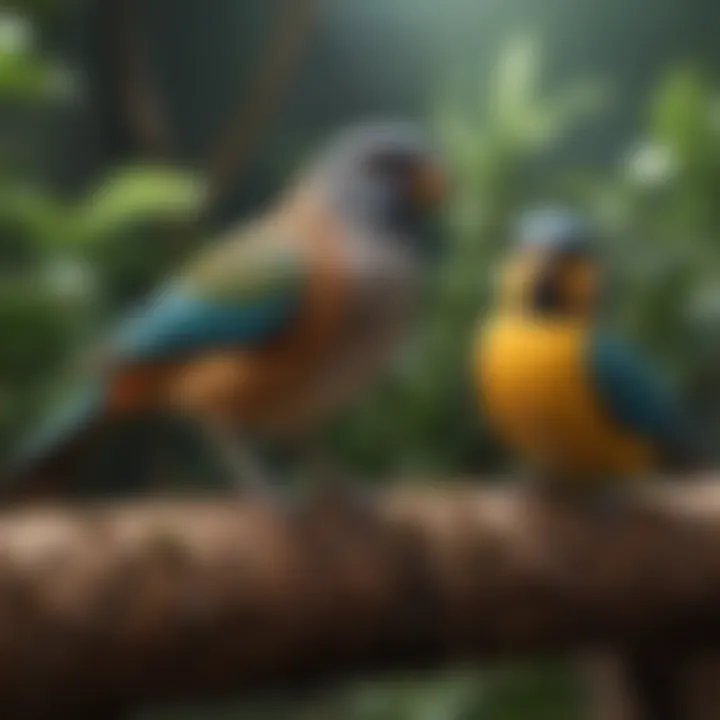
Outdoor Activities and Interaction
Under supervision, letting birds enjoy outdoor time enriches their life experience. Birds enjoy the fresh air and new sounds. Building outdoor aviaries offers a secure space for exploration while allowing for bird engagement with fresh environments.
DIY Projects for Mental Stimulation
Creating makeshift indoor birds’ playgrounds can stimulate their minds. Using everyday materials, parents can involve children in constructing activities that engage both creativity and functional interaction with their birds. Ensuring that materials are safe for their feathered partners will establish a safer exploration.
By thoroughly considering pet bird care, parents can create a nurturing and educational environment for their children, reinforcing responsibility and emotional understanding in respectful majestic creatures.
Understanding the Benefits of Pet Birds for Children
Choosing to have a pet bird can significantly impact a child's development. Birds offer a unique blend of companionship, joy, and responsibility that few other pets can provide. Understanding the advantages of bird ownership is essential for parents considering this decision.
Emotional Benefits
Having a pet bird can bring numerous emotional advantages for children. Interacting with a bird can foster a sense of caring and empathy. As children learn to take care of their feathered friends, they develop a more profound understanding of their responsibilities. Birds can also serve as a source of comfort, especially during difficult times. This connection can help mitigate feelings of loneliness and strengthen emotional expression.
Parents often find that their children become more engaged when they have an active pet like a bird. Kids watch their behaviors, mimic their nuances, and form a bond that enhances family dynamics. Furthermore, there's evidence that interacting with animals, including birds, can reduce levels of stress and anxiety.
Educational Aspects
Beyond emotional enrichment, pet ownership fosters educational growth. Children can learn about anatomy, habits, and the biological requirements of pet birds. They can explore basic pet care practices, such as feeding and grooming, giving them hands-on experience in biology.
Moreover, children strip complex information down to practical tasks. Every aspect of bird care requires time management, as birds are routine creatures. Children must learn to adhere to schedules, further honing time management skills. Such practices can translate into improved performance in their schoolwork and other activities.
> Forming lifelong skills: Owning a bird can provide children valuable life lessons, shaping their identities and skills for the future.
Social Interaction
Owning a pet bird can enhance children's social skills. These pets often become topics for conversation among peers, providing common ground for friendships. Children may also share their experiences with their birds, engaging others in their stories, which aids in communication skills.
Additionally, the responsibility of caring for a pet makes it an excellent opportunity for collaborative efforts with parents or siblings. This shared experience can strengthen relationships and improve teamwork abilities. Encouraging friendships is another significant benefit, making children understand the importance of companionship beyond human interaction.
In summary, pet birds offer children not only joy and loved companionship but a holistic development opportunity. The emotional satisfaction, alongside educational learning and social growth, plays a vital role in their upbringing.
Factors to Consider Before Choosing a Bird
Choosing a pet bird is a decision that brings long-term responsibilities and adjustments. Selecting the right bird involves careful assessment of several key factors. Each element should align with your family's lifestyle and readiness to engage in bird care.
Living Space Requirements
Birds are dynamic creatures requiring adequate space for them to thrive. The size of the cage is crucial. A wider and taller cage allows birds to stretch their wings and move around comfortably. Budgerigars, for instance, do well in a cage of at least 30 inches in width. Cockatiels option pretty well with 30 x 18 inches. However, is is not only about the cage.
Additionally, the area surrounding the cage matters. Birds should also have time to fly outside the cage. Investing in a parrot stand or a safe, bird-proofed space allows for interaction while reducing stress for the bird. Ensure there are no hazards like sharp objects or toxic plants nearby. This prepares a suitable environment for your feathered companion.
Lifespan and Commitment
Pet birds come with varied lifespans, which potential owners must consider. Small birds tend to live for around 5–10 years. In contrast, larger birds, like African Grey parrots, can live up to 60 years. Understanding these timelines can define the level of commitment needed. Such long-lived animals may live beyond childhood, impacting the family's dynamics.
Interesting, understanding the commitment does not stop at just lifespan. It also includes daily requirements like feeding, cleaning, and interaction. Older children may take on these responsibilities responsibly. Throughout their years, tasks will shift as the bird ages. Skipping these considerations leads to possible downsides for both child and bird.
Allergy Considerations
Before selecting the bird, allergic reactions should be taken into account. Bird dander might evoke symptoms in sensitive individuals. That's why investigating specific bird species becomes vital. Cockatiels are often viewed as suitable options since they tend to produce less dander compared to others, but this varies per individual.
While considering allergies, it may be beneficial to arrange for trials. Firstly, spend time with the bird species you’re thinking about before final decisions. Observe if any family members show signs of sensitivities in those settings. Investigating environments—also helps ascertain a pet that provides shared joy without risks of health adverse reactions. Prepare a healthy family atmosphere where pets have a proper place in life.
Being mindful of living conditions, commitment levels, and allergies enhances the chances of a fulfilling relationship with your pet bird.
Popular Bird Species for Children
Choosing the right species of pet bird is crucial for a successful and enriching experience for both the child and bird. Different bird species come with unique attributes, behaviors, and care requirements that parents must consider. These factors can significantly affect the pet’s integration into the family and the quality of interactions between the child and the bird. Understanding various breeds allows parents to make informed choices that suit both the child's needs and the bird's well-being.
Budgerigar
Budgerigars, commonly known as budgies, are one of the most popular pet birds worldwide. They are small parrots known for their lively nature and vibrant colors. Budgies tend to be friendly and sociable, making them a perfect match for families with children. They can easily bond with people and often learn to speak words and phrases, which adds to their charm.
When selecting a budgie, consider its personality. Young budgies are usually more adaptable and open to training, making them ideal for children. Narrative readiness and proper supervision while interacting with the bird should also be emphasized. Budgerigar care mainly includes a balanced diet, exercises, and keeping their cage clean to promote a healthy lifestyle.
Cockatiel
Cockatiels are recognized for their distinctive crest and friendly disposition. These birds are slightly larger than budgies, and they have a calm demeanor that appeals to children. Cockatiels can mimic sounds but are less likely to speak compared to budgies. They tend to develop strong bonds with their owners and enjoy interacting, making them immensely affectionate pets.
When considering cockatiels, assessing the child’s age and ability to handle the bird with care is essential. Their moderate size allows children to hold and understand how to interact with them responsibly. Ensuring that they have appropriate space and engagement in cage play and social interaction will keep a cockatiel healthy and happy.
Lovebird
Lovebirds are named for their affectionate nature. Despite their small stature, they are known for their active and playful behavior. These birds thrive in pairs but can also bond closely with human companions. Children can enjoy the colorful plumage of lovebirds, as they come in an array of hues, enhancing visual appeal.
This species may require slightly more attention because they can be a bit more territorial than other species. Children should be prepared for this, as it may necessitate learning about appropriate social dynamics with main caregivers or other pet birds. Regular interactive playtimes can help lovebirds maintain a strong bond with your child, rewarding budding responsibilities and teamwork skills in circulating care.
Parakeet
While often used interchangeably with the term
Assessing the Child's Readiness for Bird Care
Determining if a child is ready for bird care is crucial. Owning a pet comes with numerous responsibilities. These responsibilities impact the quality of life for the bird and the child's overall development. Assessing readiness involves understanding the child’s maturity, emotional intelligence, and willingness to interact with a pet properly. It sets the stage for a healthy relationship.
Age Appropriateness
Different age groups show various abilities when it comes to spot bird care. For instance, children younger than six may lack the necessary motor skills to handle a pet bird safely. Between the ages of 7 and 10, children might be more capable. The responsibility must also depend on their psychological readiness. At this age, youngsters often exhibit interest in supervising tasks but may require guidance. Activities such as feeding and maintaining the cage can be introduced during these formative years.
For pre-teens and teenagers, the capacity for empathy is often deeper, supporting a better bond with a pet. Older kids can partake more fully in setting up the bird’s environment and learning about their specific needs. They are also more likely to engage in training sessions, fostering a unique relationship. Parents should observe their child's interest in related activities, such as reading about birds or watching documentaries to assess their readiness further.
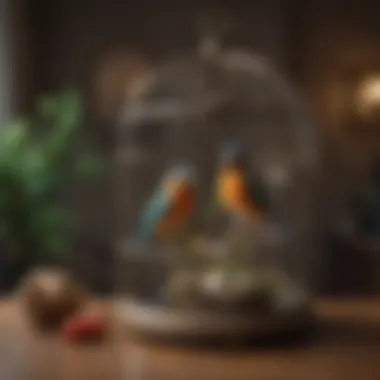
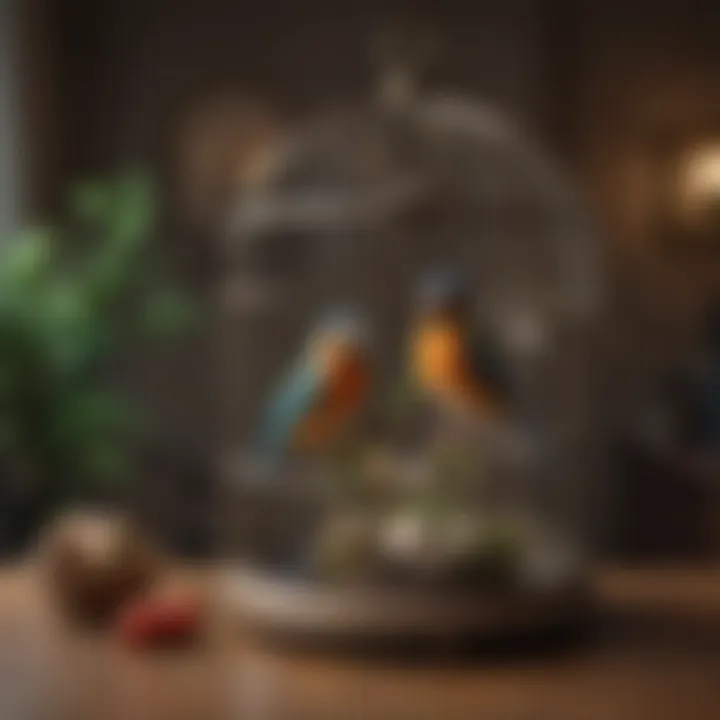
Understanding Responsibilities
Recognizing what owning a bird involves is essential. Simple tasks include feeding, cleaning, and allowing for playtime outside the cage. These responsibilities provide a sense of routine in the child’s daily life. Discussing what caring for a bird entails can prepare the child for potential challenges. For example, teaching them how to identify when the bird appears unwell ensures they become aware of the bird's health.
It is vital to communicate that bird ownership ultimately depends on their commitment and reliability. Make lists about daily, weekly, and monthly tasks needed for bird care, highlighting how much cooperation matters.
- Daily tasks: Feeding, water checking, monitoring behavior.
- Weekly tasks: Cleaning the cage, changing bedding, inspecting toys.
- Monthly tasks: Vet check-up, renewing supplies, cage deep cleaning.
Highlighting these responsibilities can enrich the child's comprehension of pet ownership. It ensures they develop a responsible character while enjoying the emotional and educational benefits that come with having a pet bird. Successful bird care relies not only on the child’s eagerness but also on parental guidance to nurture this readiness effectively.
Creating a Suitable Environment
Creating an appropriate environment for a pet bird is crucial. It not only ensures the bird's health but also affects how well your child bonds with the bird. An adequately set-up living space reduces stress for the bird, which is essential for its well-being. Additionally, it encourages interaction and helps develop a healthy relationship between your child and the pet.
Cage Requirements
When selecting a cage, size matters significantly. The cage should be spacious enough for the bird to move around freely. A bird should have the ability to flap its wings without hitting the cage sides. It’s generally recommended that the cage's width be at least two times the wingspan of the bird, and its height should allow for comfortable perching.
Ventilation is an equally important aspect. Look for cages with adequate air circulation to keep the environment fresh. Vertical space is also something to consider since many species like to climb. A cage that’s wider rather than just taller may not be the best fit, especially for smaller birds.
Make sure that the bars are appropriately spaced—too far apart can lead to escapes or injury. The material of the cage can impact health as well; opt for non-toxic materials to ensure the safety of your bird. Place various kinds of perches and toys inside to foster mental stimulation. Careful consideration is key here, as this environment affects how your child interacts with their new feathered friend.
Safety Measures
Safety in the bird's environment goes beyond the cage itself. Ensure all areas where the pet will roam are secure and free of hazards. Birds are naturally curious and will explore their surroundings. Removing unsecure furniture, sharp objects, or any potential choking hazards is vital.
Always supervise your child when they are with the bird. Children might unintentionally handle a bird roughly or drop it. Instruction on gentle handling must be enforced.
In addition to physical safety measures, also consider the environmental surroundings. Avoid exposure to toxic substances. Facst like cleaning supplies, nonstick cookware fumes, and certain plants can have a detrimental effect on birds. Knowing what is safe for the bird is an important part of preparing a suitable environment.
By understanding the specific cage requirements and implementing necessary safety measures, the journey into pet bird ownership can foster an enriching experience. Not only does it set the stage for a healthy living condition, but it also allows meaningful interactions between your child and their new avian companion.
Nutrition and Diet for Pet Birds
The diet of a pet bird is a fundamental aspect that can affect not only its physical health but also its overall well-being. Proper nutrition can improve a bird's longevity, enhance its appearance, and provide the energy necessary for routine activities. Moreover, when engaging with children, a balanced diet can facilitate learning about nutrition and responsibility. For parents, understanding the dietary needs of birds is essential to foster a successful pet ownership experience alongside their children.
Basic Dietary Needs
The basic dietary needs of pet birds primarily focus on a blend of seeds, pellets, fresh fruits, and vegetables. Each species of bird may exhibit slight variations in dietary requirements, but a few general principles apply.
- Seeds provide a source of energy and fat. However, seeds alone are often not enough due to high-fat content.
- Pellets are formulated to meet the specific nutritional needs of different species, containing vitamins and minerals.
- Fresh fruits and vegetables should make up about 20% of a bird's diet. Varieties such as leafy greens, carrots, and berries can be beneficial. It can introduce essential vitamins and personal preferences at an early age.
Most importantly, always ensure the availability of fresh water. Birds rely on hydration to aid in digestion and overall health, making it a critical component of their diet.
Bonding with the Bird
Bonding with a pet bird is a vital aspect of pet ownership that deeply enhances the relationship between child and bird. This connection not only fosters responsibility in children but can also lead to mutual trust and regard. When a child learns to bond with a bird, they gain valuable experience in empathy, patience, and caregiving.
By connecting emotionally with their future feathered companions, kids are more likely to take an active role in the bird's well-being. Strong bonding encourages children to engage in daily bird care routines. It instills a sense of responsibility as they learn that a bird needs attention, proper feeding, and everyday interaction to thrive. Moreover, bonding creates positive experiences that often translate home activities, such as communication skills and problem-solving.
Training and Interaction
Training a pet bird is not merely about teaching tricks; it forms the basis of a functional relationship. Consistent interaction can significantly improve the bond between the child and bird. Along the way, both parties learn respect and understanding. Structuring interactions encourages the child to voice their approaches, remarking on the decision corresponding a behavior of the bird. Maintaining simple commands and daily chats can establish initial pathways of communication.
Training often involves:
- Developing verbal commands, such as “step up” or “come here”.
- Using treats for reinforcement. Parakeets, for instance, respond best to small seed rewards.
- Regular repetitions of simple behaviors to foster recognition. The child can learn the effective means of communication as progress becomes visible. Training frameworks may involve frequent mini-sessions that are simple yet engaging to sustain focus and enthusiasm.
As the training deepens, more complex techniques may be viably introduced, expanding the bird's capabilities while further entrenching the bond between child and pet.
Recognizing Behavioral Cues
Understanding a bird's behavior offers insights into their emotional state. Non-verbal cues provide essential information irrespective of how adept the trainer is. Recognizing these signs allows for adapting interactions to support a positive experience for both the child and the bird. For example, observing how the bird reacts to being handled could guide children on respecting their Limits and assert control over social interactions.
Common behavioral signs include:
- Body Posture: A bird standing tall or slightly fanned feathers can indicate confidence, while a bird crouched with feathers fluffed might evoke distress.
- Beak Gestures: Bill widening can mean curiosity, while rapid beak clattering can signify agitation or fear.
- Vocalizations: Different sounds carry distinct messages. Soft trills might show comfort or playfulness, while loud screeches point to displeasure.
Learning to decode these signs fosters a harmonious interaction. Equipped with knowledge about behavioral cues, children can constantly assess the mood and well-being of their pet, consequently maintaining a healthful relationship. Recognizing, understanding, and adapting poses a significant enhancement in the overall interactional dynamic.
In summary, the bond between a child and a pet bird progresses through effective training and understanding of behaviors. It is essential for developing a fulfilling experience for both. A flourishing companionship not only benefits the bird's well-being but also nurtures vital life skills within the child.
Addressing Common Challenges
Addressing common challenges plays a crucial role in ensuring a positive experience when introducing a pet bird into a child's life. Families must be prepared to encounter issues, which can range from behavioral problems to address fears. Investing time and thought into these situations leads to effective solutions and lays the foundation for nurturing a harmonious relationship between the child and the bird.
Handling Aggression
Bird behavior can often present unexpected challenges, particularly aggression. It is not uncommon for a new pet bird, in particular species like cockatoos or amazon parrots, to show signs of aggression, especially during the early days in a new environment. Various factors can cause this behavior. Stress from a change in living conditions, improper handling, or even fear are possible triggers.
To address this, it is important for parents to be patient and adopt a calm attitude. Gentle, firm handling can help in fostering trust. Avoid encouraging behaviors that might provoke the aggression. Instead, allow the bird to feel secure in its new space. Training techniques, such as conditioning with treats or positive reinforcement, can lead to a more balance response. Seeking advice from a qualified avian veterinarian or a bird behaviorist can provide additional strategies tailored to your specific pet bird.
Tip: Maintain consistency in the bird's routine, as predictable habits can greatly reduce anxiety and aggression.
- Spend daily time with your bird on trust-building exercises.
- Always approach the bird slowly and calmly.
- If aggression persists, reevaluate the handling methods and environment setup.
Overcoming Fear of the Bird
Introducing a new bird to a home can create apprehension, particularly among children. Fears of being bitten or the bird flying away may lead to a reluctance to interact. This initial fear can hinder the bonding process. Solutions need to be implemented as soon as possible to ensure mutual comfort.
Gradual introductions are key. Begin by having the bird in a secure cage where the child can observe without direct contact. Discussing bird behaviors and what to expect can allow the child to understand the new family member better. Additionally, spending time in proximity to the bird can serve to lessen fear over time. Teaching gentle handling can also go a long way.
- Plan short, positive exposure sessions to avoid overwhelming the child.
- Allow the child to initiate interaction when they feel ready.
- Integrate reading about birds to foster interest and understanding is helpful.
By focusing on both these challenges, families create a more enriching experience while ensuring safety and comfort. Dealing thoughtfully with aggression and fear directs not only to a stable environment but deepens the bond between child and bird.


Health Considerations for Pet Birds
When engaging in the profound commitment of pet ownership, the health of your chosen bird stands as a cornerstone of responsibility, especially for parents guiding their child through the journey of avian companionship. Correctly managing health aspects can extrapolate upon many enjoyable interactions between birds and young handlers. The importance of health considerations is paramount in achieving a longer and happier life for your pet bird. Thus, being informed introduces multiple advantages for both the child and the bird.
Regular Vet Check-ups
Establishing consistent vet visits is an integral part of ensuring the well-being of your pet bird. Although birds exhibit intriguing abilities of camouflage, they can be remarkably skilled at hiding illness until it has reached a critical stage. Regular veterinary check-ups are not solely about disease prevention; they can identify minor issues before they transform into severe conditions.
During routine exams, avian veterinarians conduct comprehensive assessments, including:
- Checking for signs of nutritional deficiencies
- Assessing feather condition and presence of molting
- Listening for irregular heart or respiratory sounds
- Conducting tests for common health disorders
Being proactive with veterinary care reinforces good health habits for your bird and provides a chance for age-specific vaccinations where applicable. Furthermore, children learn the principles of responsibility and empathy as they accompany their pets during veterinarian visits. Engaging them in discussions regarding findings can redirect any fear they may feel regarding check-ups into educational opportunities.
Recognizing Sickness Symptoms
Knowledge about health signs and behaviors allows parents and children to act swiftly when issues arise. Identifying and responding to sickness may be an essential aspect of avian care.
Typical symptoms that warrant immediate attention include:
- Changes in appetite, whether decreased or increased
- Changes in droppings, including consistency and color
- Sudden shift in behavior, such as lethargy or aggression
- Fluffed-up feathers that do not return to normal positioning over time
Moreover, educating your child to monitor these behaviors creates a strong bond between the bird and your family. Encouraging children's diligence in observant care is essential. It indirectly develops a culture of compassion in their approach to living things.
Promoting Positive Interactions
Promoting positive interactions between children and pet birds is crucial for fostering a healthy, mutual bond. Not only do these interactions enhance the emotional connection, but they also contribute to the overall well-being of both the child and the bird. Understanding the needs and behaviors of pet birds helps children interact safely and harmoniously with their feathered friends. Considering elements such as touch, playtime, and supervision, can create a nurturing atmosphere that encourages rapport.
Encouraging Gentle Touch
Gentle touch should be a fundamental principle in interactions with pet birds. Birds are delicate creatures, and they can easily feel stressed or threatened by rough handling. Educating children on how to approach birds gently ensures the safety and comfort of both parties. This education promotes empathy, teaching children to recognize and respect the bird's boundaries.
To encourage gentle touch, parents can:
- Demonstrate proper handling techniques, emphasizing a soft touch.
- Encourage the bird to approach them first, allowing the bird to set the pace.
- Use calm voices and soothing movements to provide a reassuring presence.
When children feel confident in their ability to touch and handle birds gently, it contributes positively to the bird’s behavior. A trusting environment enhances the chance of successful interaction, fostering a friendly relationship between the child and the bird.
Supervised Playtime
Surpervised playtime is an essential part of promoting positive interactions between children and their pet birds. Allowing pet birds to spend time outside their cage can stimulate their natural behaviors and provide them joy. However, this freedom requires careful observation to ensure safety. Children should be encouraged to engage in structured playtimes while parents supervise.
During supervised playtime, it is important to consider:
- Selecting a safe area free from hazards like toxic plants, small objects and predator dangers.
- Introducing toys appropriate for the bird’s size and breed to encourage interaction and exploration.
- Ensuring the child understands to respect the bird's cues, like signs of fear or aggression, to maintain a calm environment.
Playtime not only strengthens the bond between the child and the bird but also allows children to learn about responsibility and regard for the creature’s well-being. This engaged presence helps pet birds develop personalities and can lead to more vibrant, happy behaviors.
Always prioritize safety during interactions with pet birds. Educating children about body language, both of themselves and the bird, can significantly enhance their handling skills.
Promoting positive interactions is not just about encouragement; it necessitates guidance, understanding, and proper knowledge. Through gentle touch and supervised playtime, parents can ensure that the relationship between their child and pet bird grows strong and affectionate.
Support Resources for Parents
Choosing the right pet bird involves thorough research, especially for parents wanting to ensure the best for their child. Support resources play a crucial role by providing information and community support.
Information is the cornerstone of responsible pet ownership. It allows parents to understand not only the specific needs of various bird species but also their general care requirements. With resources available, parents can make an informed decision and remain confident in handling potential challenges.
Furthermore, support resources help foster a sense of community among pet bird owners. This support is valuable for problem-solving and motivation. They can contribute to enhancing the child's overall experience as well, given that sharing knowledge often breaks down the complexities surrounding pet care.
Research shows that pet ownership, when supported by adequate resources, significantly improves both the pet and owners' welfare.
As a responsible pet owner, understanding that learning is a continuous process aid parents in day-to-day care. Thus, exploring resources can influence a wider understanding of care and enhance enjoyment for both child and pet.
Books on Bird Care
Books are fundamental in obtaining the right information about bird care. They uniquely combine expert knowledge with practical advice specific to each bird species. Parents often search for authoritative texts to guide the care of their child's avian companions. Titles such as The Bird Care Book and works by expert avian veterinarians provide deep insights into various aspects, including feeding, behavioral traits, and proper habitat.
When choosing books, look for those that address:
- Species-specific care
- Social needs of pet birds
- Signs of common health issues
- Strategies for bonding with the bird
These elements can guide parents significantly, offering comforting and structured insights.
Online Communities and Forums
The presence of online communities and forums has modernized how pet owners communicate and share knowledge. Platforms such as Reddit and Facebook have numerous groups dedicated to pet birds. Within these communities, parents can ask specific questions, share experiences, and connect with seasoned bird owners
Engaging in discussions on platforms like reddit.com allows access to real-time solutions since responses are often personalized to unique concerns raised by parents. Additionally, these platforms offer:
- Shared experiences from other parents dealing with similar challenges.
- Immediate advice on bird behavior concerns.
- Learning opportunities about advancements in avian care.
Furthermore, participation in forums cultivates patience and compassion within children. Being exposed to thoughtful dialogue ensures that the youth can learn alongside their parents, cementing the human-animal bond more effectively. Through knowledge sharing, both parent and child can together navigate the journey of bird ownership successfully.
Ending
Selecting a pet bird for your child is a significant decision with numerous implications. It involves considering not just the breed and its characteristics but also how well the bird can integrate into your family's lifestyle. Many factors come into play, such as the emotional benefits that birds can bring to children. Children can develop compassion and responsibility through pet care. These interactions can enhance emotional intelligence, teaching kids how to empathize with living creatures.
Aside from the emotional aspects, educational components are equally crucial. Engaging with birds can encourage children to learn about biology, behavior, and nurturing practices. The care required for pet birds fosters a hands-on understanding of responsibility and good habits. Children benefit from learning about daily routines, which can include feeding, cage cleaning, and social interaction with their new feathered friend.
It is essential for parents to assess their readiness for this commitment, including understanding the maintenance, space requirements, and overall needs of a bird. Proper planning ensures that a pet bird remains a loving and supportive addition to the family. Moreover, understanding various species and their specific traits allows for a better match between the bird and child's personality.
Establishing a dynamic that nurtures both the child and the bird positively impacts their long-term bond. Thus, by carefully considering these elements, parents can cultivate enriching relationships for both their children and the pets they care for.
Final Thoughts on Pet Birds for Children
Pet ownership, specifically with birds, offers compelling advantages. Keeping a bird helps children explore their soft skills while navigating complex emotional landscapes.
This journey of bird ownership cultivates key life skills, like empathy, responsibility, and socialization. It encourages a nurturing approach, where children learn routines that teach direct consequence. Through daily care, they observe the wonders of nature and develop reliable relationships with their pet. Parents play a pivotal role in guiding their children toward these insights.
As parents look toward introducing a pet bird, it becomes vital to continually educate themselves. TheyT continue gathering resources by reading literature on avian care or joining community discussions on forums such as Reddit. By exchanging first-hand experiences online or by attending workshops, parents forge a deeper understanding of their commitment. When approached carefully, the relationship formed between pet birds and children can blossom into one of mutual trust and affection, enriching both their lives.















